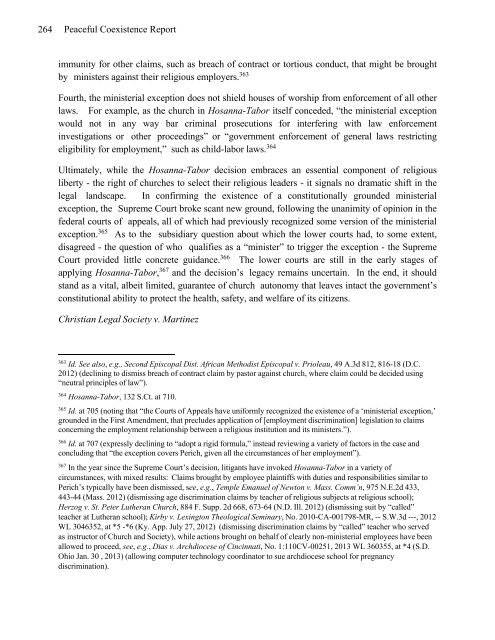PEACEFUL COEXISTENCE
2cgDkdT
2cgDkdT
Create successful ePaper yourself
Turn your PDF publications into a flip-book with our unique Google optimized e-Paper software.
266 Peaceful Coexistence Report<br />
regular meetings and other events on campus, and excluding whomever it wished. But CLS was<br />
asking for more, and the Court found no basis for mandating a special exemption from the<br />
Hastings policy. “The First Amendment shields CLS against state prohibition of the<br />
organization’s expressive activity, however exclusionary that activity may be,” the Court<br />
concluded, “[b]ut CLS enjoys no constitutional right to state subvention of its selectivity.” 372<br />
Because the Hastings policy conditioned the denial of benefits on certain conduct (the act of<br />
discriminating against certain members of the law school community) and not merely on<br />
expression (the views of the student groups) the Court held the policy was viewpoint-neutral. 373<br />
This was true, the Supreme Court reasoned, even if the policy ultimately affected some groups<br />
more than others. As the Court explained, “[e]ven if a regulation has a differential impact on<br />
groups wishing to enforce exclusionary membership policies, ‘[w]here the [State] does not target<br />
conduct on the basis of its expressive content, acts are not shielded from regulation merely<br />
because they express a discriminatory idea or philosophy.’” 374<br />
The Court also found the nondiscrimination rule to be a reasonable one, declining CLS’s<br />
invitation to second-guess the university’s policy decisions. Among other things, the policy<br />
promotes the basic principle of equality and fairness, in the crucial context of a public<br />
university. 375 Because of the central role that access to education plays in personal and<br />
professional development, eliminating discrimination in education has long been recognized as a<br />
government interest of the utmost importance. 376 As the Supreme Court had noted in an earlier<br />
case, “ensuring that public institutions are open and available to all segments of American society<br />
. . . represents a paramount government objective,” and “nowhere is the importance of such<br />
openness more acute than in the context of higher education.” 377<br />
Again, it is important to remember that the Hastings policy furthered these goals not by silencing<br />
exclusionary groups like CLS, not by driving them off campus, but rather by choosing not to<br />
subsidize them. When a public university decides that the advantages associated with official<br />
recognition should be granted only to those organizations that do not discriminate, it furthers a<br />
compelling interest in preventing government resources from being used to perpetuate inequality.<br />
372<br />
Id. at 2978.<br />
373<br />
Id. at 2994.<br />
374<br />
Id. (quoting R.A.V. v. St. Paul, 505 U.S. 377, 390 (1992)).<br />
375<br />
Id. at 2989 (“[T]he open-access policy ‘ensures that the leadership, educational, and social opportunities afforded<br />
by [recognized student organizations] are available to all students.”’) (quoting Brief for Hastings at 32, and citing Brief<br />
for American Civil Liberties Union at 11).<br />
376<br />
See, e.g., Norwood v. Harrison, 413 U.S. 455, 469 (1973) (holding that Mississippi could not give textbooks to<br />
students attending racially segregated private schools because “discriminatory treatment exerts a pervasive influence<br />
on the entire educational process”); see also, e.g., Bob Jones Univ. v. U.S., 461 U.S. 574, 604 (1983) (“[T]he<br />
Government has a fundamental, overriding interest in eradicating racial discrimination in education.”).<br />
377<br />
Grutter v. Bollinger, 539 U.S. 306, 331-32 (2003) (internal citations and quotation marks omitted).


